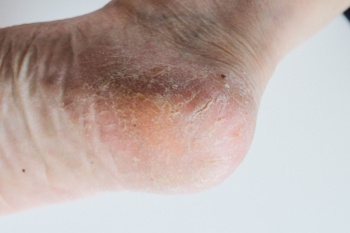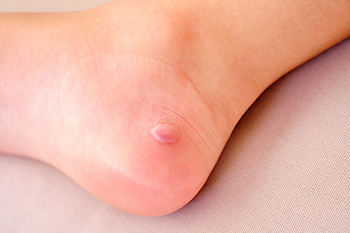Connect With Us
Blog

Cracked heels develop when the skin on the feet becomes dry and loses its elasticity, leading to painful fissures. One common cause is prolonged pressure on the feet from standing for long hours or wearing shoes with inadequate support. Dry skin, often worsened by cold weather or dehydration, makes the heels more prone to cracking. Athlete's foot, a fungal infection, can cause peeling and flaking that leads to skin breakdown. Conditions such as eczema and psoriasis contribute to excessive dryness and inflammation, further increasing the risk of heel fissures. Without proper care, cracks can deepen and cause discomfort or infection. If you notice the beginning symptoms of cracked heels, it is suggested that you promptly contact a podiatrist who can offer you effective relief and prevention tips.
If the skin on your feet starts to crack, you may want to see a podiatrist to find treatment. If you have any concerns, contact Larry Slomowitz, DPM from California. Our doctor can provide the care you need to keep you pain-free and on your feet.
Cracked Heels
It is important to moisturize your cracked heels in order to prevent pain, bleeding, and infection. The reason cracked heels form is because the skin on the foot is too dry to support the immense pressure placed on them. When the foot expands, the dry skin on the foot begins to split.
Ways to Help Heal Them
- Invest in a good foot cream
- Try Using Petroleum Jelly
- Ease up on Soaps
- Drink Plenty of Water
Ways to Prevent Cracked Heels
- Moisturize After Showering
- Skip a Shower
- Keep Shower Water Lukewarm
- Don’t Scrub Your Feet
If you are unsure how to proceed in treating cracked heels, seek guidance from a podiatrist. Your doctor will help you with any questions or information you may need.
If you have any questions, please feel free to contact our office located in Westlake Village, CA . We offer the newest diagnostic and treatment technologies for all your foot care needs.

Advancements in forefoot surgery are providing better treatment options for conditions that cause chronic pain and mobility issues. Mallet toes and hammertoes develop when toe joints become bent due to muscle imbalances, often leading to stiffness, corns, and discomfort. Traditional correction methods required significant recovery time, but newer techniques use tiny implants or absorbable pins to realign the toes with minimal scarring and faster healing. Neuromas, which cause burning pain or numbness between the toes, result from thickened nerves due to prolonged pressure or irritation. Instead of removing the nerve entirely, modern approaches focus on nerve decompression or cryoablation, reducing symptoms while preserving function. Metatarsophalangeal joint instability, or MTP, can lead to toe dislocation and chronic joint pain. Innovations in ligament repair and joint-stabilizing implants help restore alignment and prevent future dislocations. These surgical improvements mean less pain, quicker recovery, and better long-term function. If foot pain is affecting your daily life, it is suggested that you see a podiatrist who can discuss the best treatment options available.
Foot surgery is sometimes necessary to treat a foot ailment. To learn more, contact Larry Slomowitz, DPM of California. Our doctor will assist you with all of your foot and ankle needs.
When Is Surgery Necessary?
Foot and ankle surgery is generally reserved for cases in which less invasive, conservative procedures have failed to alleviate the problem. Some of the cases in which surgery may be necessary include:
- Removing foot deformities like bunions and bone spurs
- Severe arthritis that has caused bone issues
- Cosmetic reconstruction
What Types of Surgery Are There?
The type of surgery you receive will depend on the nature of the problem you have. Some of the possible surgeries include:
- Bunionectomy for painful bunions
- Surgical fusion for realignment of bones
- Neuropathy decompression surgery to treat nerve damage
Benefits of Surgery
Although surgery is usually a last resort, it can provide more complete pain relief compared to non-surgical methods and may allow you to finally resume full activity.
Surgical techniques have also become increasingly sophisticated. Techniques like endoscopic surgery allow for smaller incisions and faster recovery times.
If you have any questions please feel free to contact our office located in Westlake Village, CA . We offer the newest diagnostic and treatment technologies for all your foot and ankle needs.

Blisters are a common issue for ballet dancers due to the intense physical demands placed on their feet. Constant friction from ballet shoes, especially pointe shoes, can cause the skin to rub against the shoe material, leading to fluid-filled blisters. Moisture from sweat softens the skin, making it more prone to irritation and breakdown. Repetitive movements such as turning, jumping, and balancing place pressure on specific areas of the foot, increasing the likelihood of blister formation. Ill-fitting shoes or improper padding can also contribute to excessive rubbing. Additionally, dancers who transition to pointe work too quickly may experience more severe blisters as their feet adjust to the strain. A foot blister can be uncomfortable and may cause dancing to stop until it completely heals. If you enjoy dancing and have developed blisters, it is suggested that you confer with a podiatrist who can offer effective relief and prevention tips.
Blisters are prone to making everyday activities extremely uncomfortable. If your feet are hurting, contact Larry Slomowitz, DPM of California. Our doctor can provide the care you need to keep you pain-free and on your feet.
Foot Blisters
Foot blisters develop as a result of constantly wearing tight or ill-fitting footwear. This happens due to the constant rubbing from the shoe, which can often lead to pain.
What Are Foot Blisters?
A foot blister is a small fluid-filled pocket that forms on the upper-most layer of the skin. Blisters are filled with clear fluid and can lead to blood drainage or pus if the area becomes infected.
How Do Blisters Form?
Blisters on the feet are often the result of constant friction of skin and material, usually by shoe rubbing. Walking in sandals, boots, or shoes that don’t fit properly for long periods of time can result in a blister. Having consistent foot moisture and humidity can easily lead to blister formation.
Prevention & Treatment
It is important to properly care for the affected area in order to prevent infection and ease the pain. Do not lance the blister and use a Band-Aid to provide pain relief. Also, be sure to keep your feet dry and wear proper fitting shoes. If you see blood or pus in a blister, seek assistance from a podiatrist.
If you have any questions, please feel free to contact our office located in Westlake Village, CA . We offer the newest diagnostic and treatment technologies for all your foot care needs.

